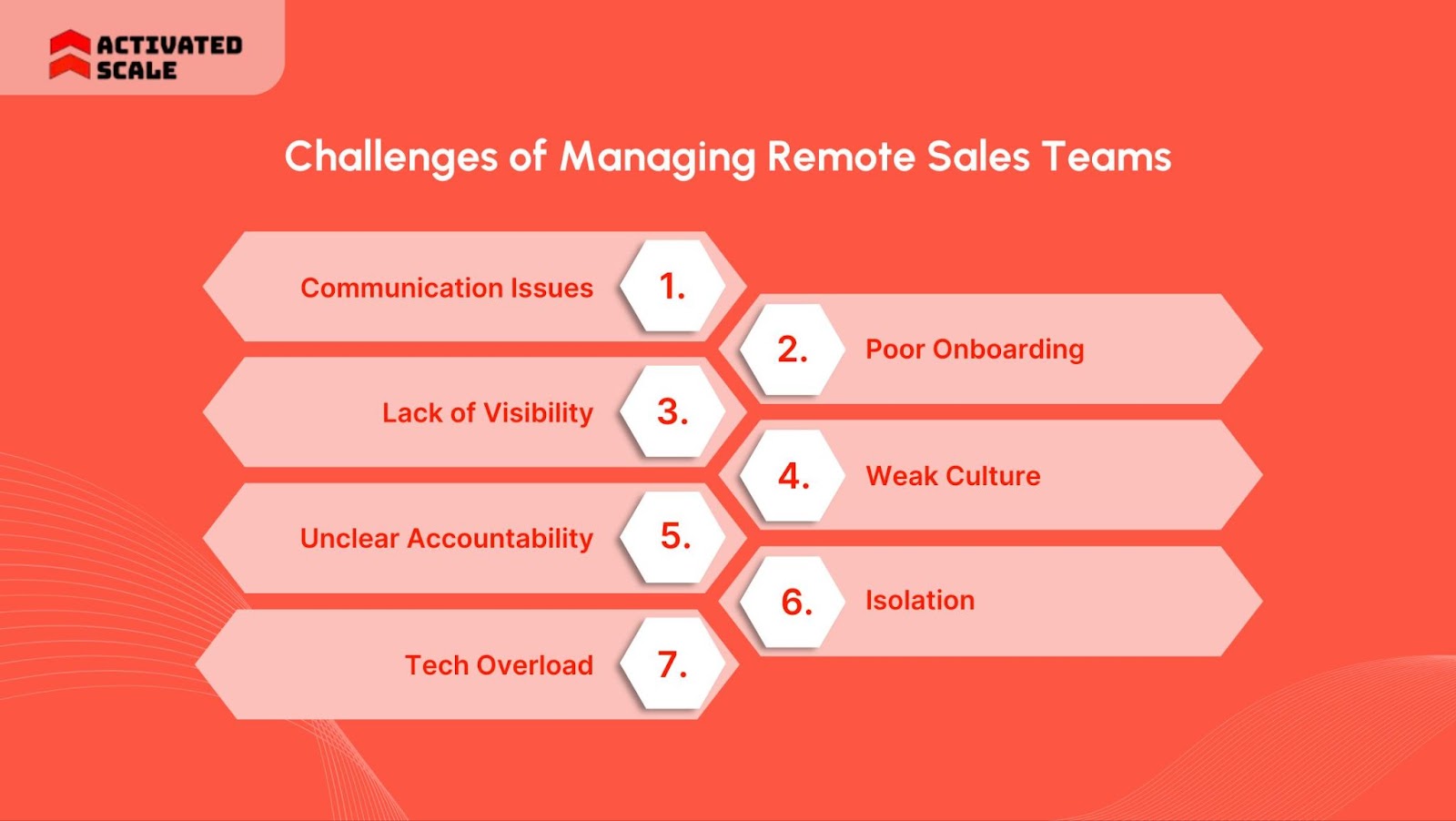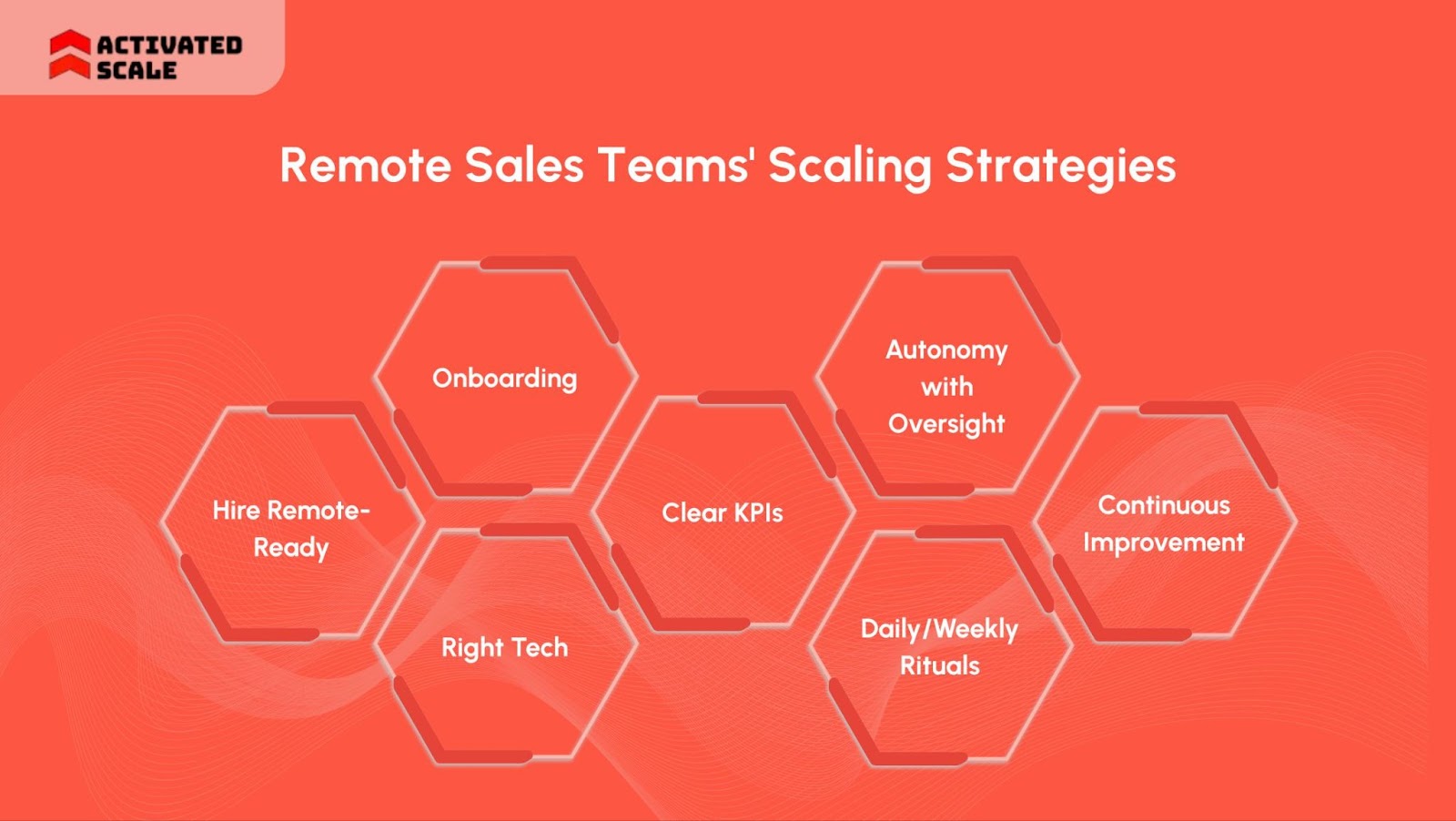Sales leaders know the challenge of building a team that delivers consistent results across time zones and tools. 40% of sales representatives consistently deviate from following the sales process. If this is what's happening for your remote sales team, you're not alone.
We understand how fragmented onboarding, mismatched hires, and weak performance visibility hurt growth. The goal? To give you actionable frameworks that support your revenue targets without bloating your headcount.
In this blog, we’ll walk through effective remote sales teams' scaling strategies that tackle those exact pain points. From running a lean startup to a Series B-funded sales organization, these insights will help you scale smarter and faster.
TL;DR
- Remote sales scaling is about leadership, onboarding, and daily performance rituals that work asynchronously.
- Strategies like role clarity and KPI-driven coaching outperform "trust-based" remote models.
- Activated Scale helps your team to build repeatable sales engines that grow with you.
- Fractional sales leadership helps avoid expensive mis-hires and gives early teams access to proven GTM execution.
What Do You Need to Know About a Remote Sales Team?
A remote sales team works outside a centralized office, often across cities, regions, or even countries. These teams use tools to communicate, prospect, close deals, and report progress without in-person contact.
For B2B companies, this model offers flexibility, access to diverse talent, and better coverage across buyer time zones. But success depends on systems, not just individual skill.
Remote sales teams come in many forms, such as fully distributed, hybrid, or geographically tiered. Each has trade-offs in terms of visibility, culture, and the speed of collaboration.
When discussing the strategies of remote sales teams, understanding their benefits helps determine why these tactics are effective.
Also Read: 9 Proven Ways to Scale Your Business Faster and Smarter
Benefits of Having Remote Sales Teams
Remote sales teams reduce overhead while expanding your access to top-tier talent. You can recruit experienced closers in new markets without adding office costs. Remote sales models are effective when structured intentionally. Here’s how your business can benefit:
- Lower overhead by removing office space and relocation costs
- Access to skilled talent across markets without location limits
- Faster territory coverage through distributed time zones
- Higher productivity with flexible schedules and fewer office distractions
- Greater rep retention when autonomy and trust are built in
- 80% of B2B sales interactions between suppliers and buyers are conducted through digital channels in 2025. So, having a remote team that is highly skilled in digital marketing strategies is always beneficial.
- Clear systems allow leadership to track output without daily supervision
If hiring a full-time VP of Sales isn’t realistic for your business right now, our Fractional Sales Leadership service can help. You’ll get access to seasoned sales leaders who can build playbooks for your sales.
These benefits are real and measurable. But they don’t come without trade-offs. That’s the real tension of scaling remote sales. High upside, but only if you manage the cracks early. We need to understand where those cracks usually appear.
Challenges of Managing Remote Sales Teams

Remote sales teams also expose what your systems can’t support. Without clarity and structure, problems compound across locations. Here's where teams often struggle:
1. Communication breakdowns delay progress
Remote selling depends on fast, clear communication. When tools are scattered and expectations aren't written down, messages slip. Deals stall because reps hesitate to act or duplicate effort. This leads to missed opportunities and lower trust across the team.
2. Inconsistent onboarding slows ramp time
New reps often join without a full context. They get access to tools, but not the ‘why’ behind them. Without shadowing or structured ramp plans, early missteps become long-term habits. Poor onboarding is one of the fastest ways to lose pipeline momentum, as 80% of employees quit their jobs due to this.
3. Low visibility masks underperformance
You can’t manage what you can’t see. When data lives in different places or isn’t logged consistently, leaders struggle to coach in real time. This leads to reactive management, intervening only after numbers drop, not before.
4. Culture fades without shared rituals
Culture is built through moments. Remote teams miss out on casual celebrations, organic feedback, and peer learning. Over time, reps feel like individual contributors instead of part of a team, which affects retention and morale.
5. Accountability blurs without structure
Without defined KPIs and clear expectations, reps start guessing what matters. Some over-deliver in the wrong areas; others go silent. Without shared dashboards or weekly check-ins, it’s hard to know who’s focused and who’s drifting.
6. solation wears down performance
Reps working remotely can feel invisible. That isolation often leads to hesitation, risk avoidance, and burnout. High performers disengage when they don’t feel part of something bigger, especially if they’re hitting quota with no feedback.
7. Overloaded tech stacks hurt more than help
Adding more tools won’t fix broken processes. Reps struggle when platforms don’t sync or when every task requires switching tabs. Productivity drops when people spend more time managing software than selling.
The only solution to handle these challenges is to take proactive steps. That’s why you need practical strategies that will help you build a sales team without any issues.
Read Also: Top 9 Lead Generation Companies for Small Businesses
7 Remote Sales Teams' Scaling Strategies

Scaling a remote sales team is about setting up systems that actually help them succeed from day one to hitting quota. These seven strategies cover what it takes to build and manage with clarity and control. Here’s what you need to know:
1. Hire for Remote-Readiness
New hires shape remote success. Look for clear communication, accountability, and adaptability from day one.
Steps:
- Include a short asynchronous assignment during recruitment to test clarity.
- Ask behavioral questions on remote collaboration and time management.
- Go through their written assignment carefully if there’s one. Good writing is clear writing. If it’s hard to read, it’s failing to communicate.
20% of U.S. workers now work fully remote, signaling a rising talent pool for remote roles. Because they often outperform office-trained reps as they rely more on outcomes than presence.
2. Build a Structured Onboarding Process
A documented onboarding plan ensures a consistent ramp-up and reduces early mistakes.
Steps:
- Design a 30‑60‑90 day checklist with learning, shadowing, and solo tasks.
- Assign a peer mentor for weekly social and performance check-ins.
- Gather feedback on process clarity to refine future onboarding cycles.
26% of sales reps say their sales training lacks effectiveness, so set a clear first-month goal. Once they are habituated, let reps feel momentum early.
3. Equip the Team with the Right Tech Stack
The right tools reduce friction and help reps hit numbers.
Steps:
- Audit current tools. Remove plug-ins or apps that overlap or confuse.
- Match tools to workflows. For example:
- Communication: Use tools like Slack, Zoom, or Gather to stay in sync across time zones. Slack handles quick updates, Zoom powers deeper convos, and Gather keeps remote culture alive.
- Sales enablement: Platforms like Salesforce, HubSpot, and SPOTIO help track deals and keep field reps informed.
- Productivity: Hubstaff and Insightful offer visibility into time spent and tasks completed.
- Coaching: Gong lets you analyze real sales calls, spot trends, and coach reps with actual data.
- Project tracking: Jira and Trello make it easier to assign, prioritize, and track initiatives across your go-to-market team.
- Conduct quarterly check-ins to decide whether each tool adds value.
High-performing teams use nearly 3.6X more tech than underperformers. That’s why choosing the right tools for your team is highly crucial.
4. Set Clear Key Performance Indicators (KPIs)
Define success with transparency and accountability. On the other hand, holding individuals accountable for their roles ensures everyone understands their contributions.
Steps:
- Select 3–5 metrics (e.g., outreach volume, calls-to-meetings, deal velocity).
- Use shared dashboards to update metrics in real time.
- Run weekly review meetings to align on metrics and adjust tactics.
High-performing teams should prioritize performance data. So, make data visible daily. That’s the fastest path to behavioral change.
5. Create Daily and Weekly Rituals
Consistent routines drive focus, enhance productivity, and ensure everyone stays on track towards common goals.
Steps:
- Host brief “stand-ups” to share daily priorities and celebrate small wins.
- Review pipeline weekly, surface at-risk deals before they slip.
- Rotate rep-led sessions to foster accountability and peer connection.
Routine rituals create a sense of connection and shared purpose in dispersed teams. It helps to create a cohesive culture despite physical distance.
6. Promote Autonomy with Built-In Oversight
Balance freedom with structured visibility by allowing autonomy while ensuring clear processes to maintain accountability.
Steps:
- Let reps plan their days; hold them accountable to output.
- Use CRM check-ins, not micro-visibility, as oversight.
- Provide monthly 1:1s to address roadblocks and development goals.
77% of remote workers report higher productivity with flexibility. So, all you need to do is trust your team after you have provided them with the required tools. Visibility wins execution. So, learn to trust your team without micromanaging.
7. Continuously Improve Through Feedback and Data
Treat your team as a product by continuously assessing performance to enhance their skills, efficiency, and collaboration over time.
Steps:
- Survey reps monthly on tools, workflows, and morale.
- Review win/loss data to identify friction points.
- Pilot changes on small groups before organization-wide rollout.
73% of buyers now expect personalized interactions. Let your customers and your reps co-create your processes.
We understand that running a business while managing a team isn’t easy. That’s why we at Activated Scale are here to help you.
Also Read: Understanding and Measuring Sales Effectiveness
How Activated Scale Helps You Scale Remote Sales Teams
Remote scaling demands a strategy, structure, and execution. Activated Scale offers hands-on services that plug directly into your team’s workflow and growth goals.
Here’s how we help:
- Fractional Sales Leadership: Get experienced sales leaders without the cost of a full-time hire. Perfect for remote teams that need strategic oversight, fast.
- Fractional Selling: From sales development representatives (SDRs) to account executives (AEs), we help you source reps for distributed teams.
- Contract-to-Hire Sales Recruiting: Hire vetted sales professionals on a flexible, trial basis before offering full-time employment.
You can now focus on product and revenue. We’ll handle the messy middle of building your remote sales engine. Schedule a call to get started.
Final thoughts
Scaling a remote sales team is a systems challenge. You need repeatable processes and a leadership layer that knows how to drive outcomes.
The remote sales teams' scaling strategies we covered, from strong onboarding to data-driven coaching, aren’t just best practices. They’re how modern teams grow without burning out or stalling at each stage.
If you’re handling this transition and need support that’s been there, Activated Scale is built for you.
From go-to-market (GTM) planning to fractional sales leadership, we help remote sales teams hit quota and stay focused. Get in touch to reach your remote sales goals.
FAQs
1. What’s the biggest challenge when scaling a remote sales team?
The biggest challenge is a lack of visibility and alignment. Without in-person oversight, remote teams need clear processes, accountability systems, and regular coaching to stay on track and hit targets.
2. How do I know it’s time to bring in fractional sales leadership?
When your team lacks sales strategic direction, but you’re not ready for a full-time VP, it’s time. Fractional leaders bring the experience you need at a fraction of the cost.
3. Can a remote sales team perform as well as an in-office one?
Yes, if built right. With clear KPIs, data-backed coaching, and a performance-driven culture, remote teams can outperform their in-office counterparts.
4 .How does Activated Scale help remote teams scale faster?
Activated Scale provides GTM planning, fractional leadership, hiring support, and coaching systems customized for distributed teams. You get structure, expertise, and hands-on support without the overhead.
The Ultimate Guide to Hiring a Salesperson!
Get the step-by-step guide to hiring, onboarding, and ensuring success!
_edi.png)




